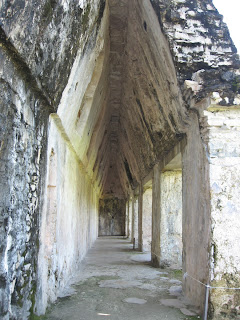Draft page - captions to add.
Palenque is a stunningly beautiful site, set amidst the steaming green jungle where avocado, orange, teak, mahogany, and the sacred Ceibal (Capoc) trees offer shade from the hot sunshine and a home to exotic birds.
The impressive Plaza Central is reached immediately from the entrance where local Maya, often dressed in white robes, tout souvenirs and foodstuffs. The main square is dominated by the Temple of the Inscriptions built to house the tomb of Pacal II who ruled for 67 years from 615 to 683AD. Despite his long reign his tomb had to be completed by his son and successor Chan Bahlam who ruled until 702. The tomb, which is down a narrow flight of steps within the pyramid was first discovered in 1952 by Alberto Ruz Lhuiller, who now lies buried opposite the temple. The famous sarcophagus lid, which Von Däniken though represented an astronaut, still lies within the temple, but can no longer be visited. To the right of the Temple of the Inscriptions however, near Temple 12, can be seen the burial of a woman, discovered in 1994, probably the wife of Pacal. From the plaza steps lead up to the palace complex, which is richly decorated with stucco and with tantalising traces of mural painting. From the upper terraces of the palace is a view across to the Temple of the Count, named after the eccentric French count Jean Frederic Waldek who lived in the structure for two years while he made highly fanciful drawings of the site. The palace has an unusual square tower which probably doubled as a watch-tower and astronomical observatory. It is thought that the astronomers used basins of water in which the reflections of the heavens assisted their observation - certainly the topmost roof is an addition of the archaeologists. A maze of damp subterranean passages can be visited with remains of latrines and sweat baths, which showed that the ruling family lived in some style. Leaving the Palace and crossing the River Otulum, which the Maya had converted into a covered channel passing beneath the Palace, steps lead up to a second plaza with three temples constructed by Chan Bahlam, the Temple of the Sun, the Temple of the Foliated Cross, and the Temple of the Cross. Two of these have the full roof combs which, like the stucco decorations in an elaborate, almost baroque style, are a distinctive feature of Palenque. All three temples contain wonderful bas-reliefs with extensive inscriptions set within shrines. Temple 18 just outside the group also has a remarkably preserved bas relief, discovered relatively recently. From the top of the Temple of the Cross is a wonderful view across the site and out over the forested lowland stretching away into the distance. Following the culvert of the Otulum river below the Palace the remarkably ball court is reached. Crossing the river again at a point where it falls in cascades down a wooded valley a path leads to the remote Group C, consisting of buildings only partly disengaged from the woodlands and hiding who know what treasures, still to be found by archaeologists.
The people of Palenque have adopted the recently discovered Mayan rulers as part of their heritage, not always in the best of taste. The profile of Pacal adorns the Town Hall and park benches. There is even a statue of his mother in the centre of the town and a giant copy of his head on the roundabout out of town!














































